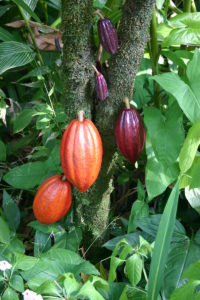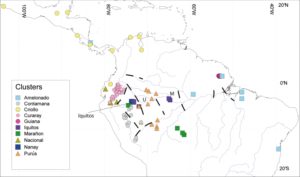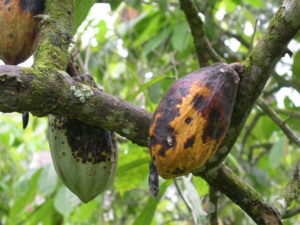In 2017 it was estimated that the global chocolate market was worth approximately 103 billion USD and it is expected to continue growing! Certainly, I suspect many of us have been consuming more of it than we normally would over the past year so let’s have a closer look at the science of Theobroma cacao, the plant from which chocolate is derived.

How long have we had chocolate and where does it come from?
Theobroma is derived from Greek and translates to “food of the Gods”, likely referring to its important role in Mayan mythology and the religions of pre-Columbian Central America. Studies looking at the genetic diversity of Cacao trees are trying to narrow down when, and where, it was originally domesticated. Previously it was thought that there were two main genetic clusters, domesticated in two separate events in Mexico and lowland South America however the more recent work suggests that there are actually around 10 distinct genetic clusters. The location of these is shown below.

Artifacts found in archaeological sites across the Americas suggest that consumption of cacao products may have started as early as 5,300 yrs ago in Ecuador. It seems to have become widespread throughout Central and Southern America over the following 1-2,000 years but it was only introduced to Europe in the 1500s by the Spanish conquerors. Within a century it was hugely popular across the continent and plantations were starting in the colonies in order to meet demand.
Why is it so delicious?
However, what we know and consume as chocolate today is very different to the original products derived from the cocoa bean. The processing of the cocoa bean has a huge influence on the taste of the final product -you only need to compare cheap milk chocolate bars to slightly more expensive dark chocolate to notice that! Beans straight from the pod are bitter tasting due to high levels of methylxanthines and theobromine, which reduce upon fermentation. At this point alcohols are introduced and proteins and carbohydrates begin to break down. The drying and roasting phases result in complex epimerisation reactions of polyphenols along with Maillard reactions. However, a lot of the subtlety of flavour comes from volatile compounds arising from all the stages of processing. For instance, 2-heptanol (produced during fermentation) is said to impart a fruity, spicy aroma, desirable in many higher quality chocolate products but it is easily removed if care is not taken with later stages of processing. The chocolate we consume today is generally a lot sweeter, with a less complex flavour profile, than the original drink.

Is climate change going to affect chocolate?
Unfortunately, the production of cacao products isn’t all tasty. The tree itself is vulnerable to pests and climate change so breeders are constantly trying to create new varieties to combat these issues. It is especially important to take these steps early with the Cacao tree because its seeds do not survive the drying and freezing required for storage in seed banks- they are recalcitrant seeds. Instead, the gene banks need to be living, fertile trees grown in the field. Large mono-cultures of a specific variety can undermine this so farmers and buyers are being encouraged to diversify their crops. This also helps to combat pest issues as different varieties can be particularly vulnerable to specific pests and large-scale pesticide use is hugely damaging to the environment. Bio-control, by inoculating seeds with a culture of Streptomyces camerooniansis, is currently under investigation, with initial results showing accelerated seed germination and reduced growth of many different harmful organisms.

Remember- Feb the 15th is a great time to get your hands on some discount chocolate!
